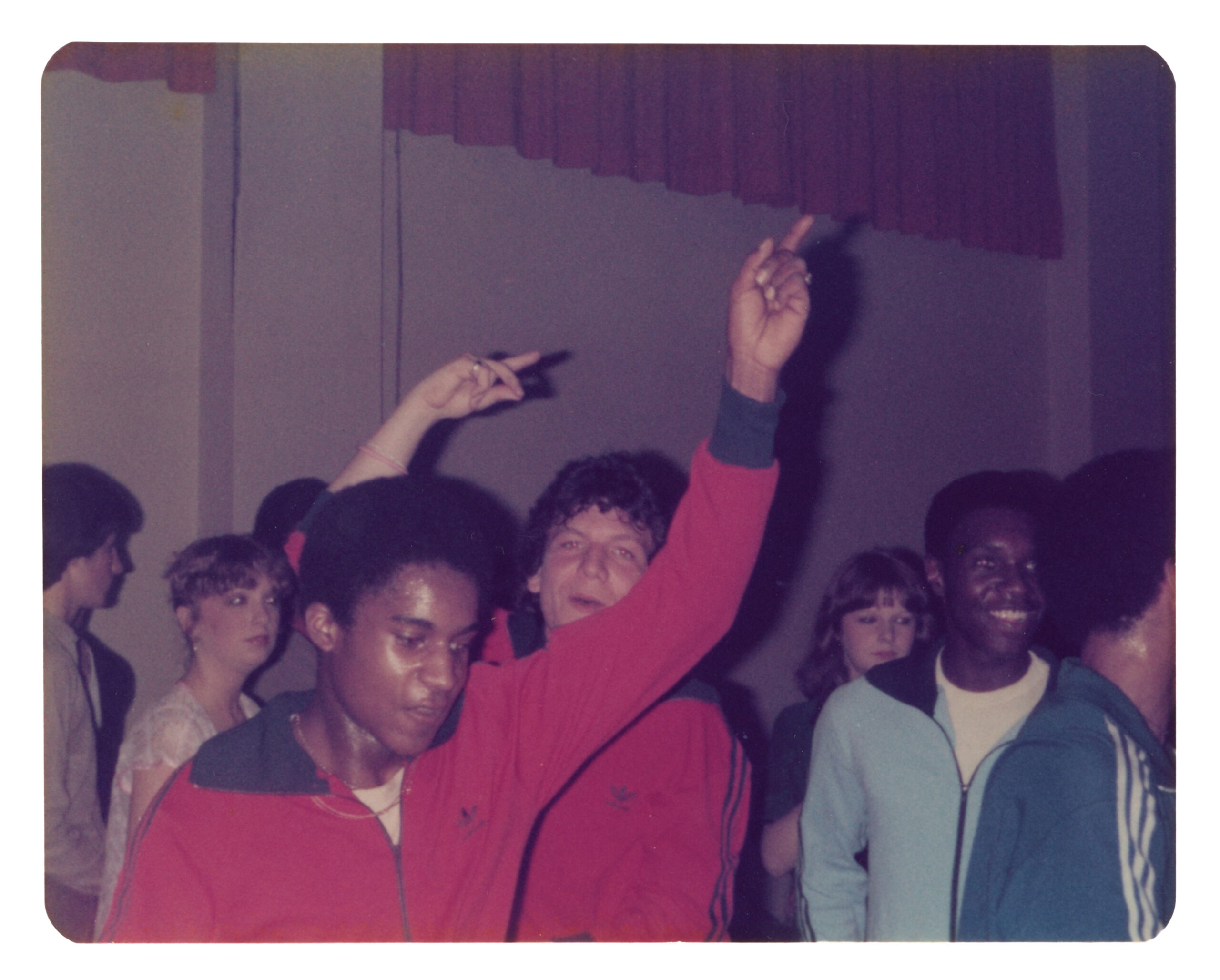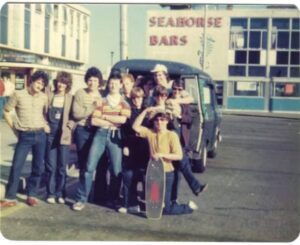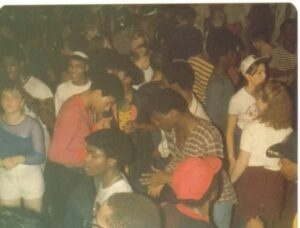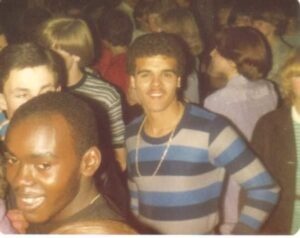

Jazz Funk & the Seventies Weekenders
With Johnny Woollard
Johnny Woollard tells us about his collection of photos taken on a small 110 camera during his days travelling the South of England with his friends at club nights and weekenders. After discovering Jazz Funk and Soul, Johnny went on to dance at sweaty clubs 7 nights a week. His images show young people absorbed by the beat in the mid Seventies.
Interview by Esta Maffrett | 09.11.22
Where did you grow up and when did you first get into music?
My family were never into music really. There must have been four or five record shops in Grove's End that I visited, to start off I was into rock music and I liked Bowie, Sparks, a bit of Queen. But it was this record shop I used to go to, this one album came through that I picked up and played, It was Places and Spaces by Donald Byrd, I heard it and it was sort of like an epiphany. It completely changed me. I was still at school and you could take records and play them at lunchtime so I took it and shared it with friends who like it as well, from then onwards I was trying to find that same sort of music from that record. I read the sleeve notes and it said produced by the Mizell Brothers so then I was trying to find anything else that the Mizell Brothers produced, It got me into Jazz but not so much traditional Jazz but the new that was coming through, I called it Jazz Funk. It was this new music that the musicians were playing because they could make more money and they were selling more because people could dance to it. Other groups started bringing out records and there was a group called Brass Construction who had an album called Movin’ and it was an absolute great track to dance to, it just got you going, we loved it. There was something about this being a new music that you had to try and find, It wasn’t in every Woolworths or Boots, you had to go to a specialist and then find the section. It changed me and I got into the fashion to go with the music, I didn’t want to be the same as everyone else.
When I was young straight men never danced in clubs, you would get called names, people who thought it was masculine to dance. But this music made you dance, you weren’t going to stand around when there was such a great beat.
How did you get into the clubbing scene? Was it a local thing or did you have to travel?
Well it was through friends from school and friends I met, we would go to the local pub that had a disco on a Wednesday night. Obviously it was young but it wasn’t like a school disco, you had to pay and prove that you were old enough to get a drink which we couldn’t but we got a soft drink. There was a DJ called Steve Maxted who played one or two dance tracks. Our friends went there because it was sort of like the beginning of the scene. So we met people there, a little group of us in our town that were into the same music at the same time, enjoying this vibe and having a good time. It was fun so our group would go into different clubs and try to find different places, because it was the beginning there wasn’t really anywhere to go. It was like a Northern scene and Northern Soul that was happening but this was a different kind of music, they had certain beats and we were more into Disco, Jazz and Jazz Funk. Through these few magazines we could see certain records or clubs that were advertised and when we saw them we wanted to go. Friends drove and you could get into these clubs, I was 16 but they asked your age and you could pretend to be anyone, someone else who was 18.
One of the first ones that we used to go to was in London in the old Heaven underneath the arches at Charing Cross Station. We would get a train up to Charing Cross and worked out that if we bought a return ticket from Victoria, when the club finished at 1 or 2 in the morning and we walked to Victoria the last train we could catch was the paper train, the one taking the Sunday papers up from London. This train would stop at certain stations to drop off the papers where the first issues would go to the shops and we could get on and be home by maybe 5 or 6 in the morning. The thing was, if the papers were late and the train got canceled, because we got a return ticket they would get us a black cab all the way home from London. It was just one of those things we found out and it was such a laugh. When we used to come to london the punk scene was happening and on the train back there was this group who called themselves the Bromley Contingent and they called us the Soul Boys. We all came from our clubs dressing in our own ways and we used to travel together home.
The next place I went to was Lacey Lady’s on a Saturday night in Ilford where my first pictures in clubs are from. That was the beginning of taking a camera, I was meeting people and the scene was beginning. It came to a point where every single night of the week you could go to a different pub, they weren’t really clubs as such but they were pubs with a side room that they put some speakers in, some lights and some decks in. Someone at the door would take your couple of pounds and people used to put nights on so there was always a place to go. There was a thing where if you put a film in you get a free film for your next one, so once you got your pictures developed you were taking it in and getting it back so I was always taking pictures.
So the camera was out as early as you started going out?
Yes from around the beginning of it. I just had a small little one, I think it was a 110 with no focus and that was it. You just had to hope for the best. Some of them were blurred, some of them were posed but I just tried to take them of anyone I saw. I wasn’t trying to get a big 35mm camera, this one was convenient, it could go in my back pocket, I carried it around, sometimes I remembered to get pictures and sometimes I didn’t.
"When we used to come to London the punk scene was happening and on the train back there was this group who called themselves the Bromley Contingent and they called us the Soul Boys. We all came from our clubs dressing in our own ways and we used to travel together home."

Were you always seeing the same faces or did you increasingly see new people joining the scene?
There were groups in the Gravesend scene that were friends, good friends but we went to see different places and we got to know more and more people from different places. Each town or club you could go to had its own little tribe as they used to call themselves.
When Pete Tong came on our scene he wasn’t really interested in the soul music as such but he got into it with Disco, Jazz Funk and got really into it to doing the big clubs and travelling all over and playing to big crowds. He was a friend so we went everywhere, I would work at Safeways early on the Monday and finish on the afternoon with Tuesday off so we would go to the Monday night club on the A20 by the West Kingsdow. I think it used to be a Cafe but it had turned into a nightclub that Pete would take over on a Monday night. Starting at 8 at night and going on to 2 or 3, every week we never knew if anyone was going to turn up because it was on a Monday. But they came out and it was packed, they came from everywhere so we had that on for a few years. Then there were 2 brothers, 1 own the Kings Lodge and one owned the Hilltop so we moved there and done the Monday and people kept filling it up.
So we were always travelling to places which led us to later on the big weekenders. That was a new thing that started where rather than going out on just one night you would go and they had a club Friday, Saturday and finish on the Sunday. The first one was in 79 and it got really big, they were up in Great Yarmouth, in a caravan park with chalets and people would all go together up there for a weekend away.
Which venues stick in your head as a favourite or always a good time?
Well my favourite was the Atantis down in Margate. That one just blew me away at times, it was crazy travelling down there, they had dancers, a load of different things went on there in this basement club. On the walls they had pictures of mermaids and sea creatures. We stayed in people’s houses or in a bed and breakfast, sometimes we snuck into the old train depots and slept in the parked up trains or sometimes 6,7,8 of us would sneak into someone else's bed and breakfast. There was always a do on each night during the bank holidays so we went down and spent time at Dreamland and have a muck about on the beach, was always nicer in the summer than the winter.
There was one local club called Wings, if you got in before 10 o’clock it was a certain price and you got a meal ticket that you could get something like chips and sausage in a basket with. It was because of the licensing laws so it meant they could stay open later. We would get there early and pay our bit have our dinner.
What was the magazine you got all your info from?
Blues and Souls. It would come out once a week and would show what clubs were on and what the DJs were playing in the clubs. It had their top 10 records which you would see what they were and sometimes had write ups about some of the clubs. You could see adverts from for different nights so knew what was coming up and the concerts as well.
The images are kind of this precursor to the rave scene. You can see a similar atmosphere and energy, possibly substances as well but it’s not really spoken about much how it was happening before.
The soul nights had amphetamines and they were dancing to slightly different beats but everyone was dancing. We used to call them blues and you bought them for a pound, took them on Friday and you were still buzzing on Monday morning. But not everyone was on drugs, some people just drank and some people were just there, some smoked as well. Everybody was there to dance and it was so hot in there. The first time I went to Atlantis I was only 16/17 and it was so hot I fainted. Once I knew I took a change of clothes, the Northern Soul dancers did that as well because it was just so hot in their clubs.
If you could put one object into the Museum of Youth Culture what would it be and why?
A little camera and a Sony Walkman. Those were the two things I always carried around and I liked the Sony Walkman because I used to take it everywhere with me, it cost me a lot of money working and I bought it from a department store.

A group of Johnny's friends in front of Seahorse bars, UK, 1970s. "I used to be young soul boy living in Gravesend Kent and going out to clubs and Discos all over Kent and Essex. I was only 16 when I went to my first Disco with my friends Tony and Tim and I used to take a small camera with me to record our nights out."

A packed dancefloor photographed by Johnny, UK, 1970s. "I used to be young soul boy living in Gravesend Kent and going out to clubs and Discos all over Kent and Essex. I was only 16 when I went to my first Disco with my friends Tony and Tim and I used to take a small camera with me to record our nights out."

A group of young men on the dancefloor photographed by Johnny, UK, 1970s. "I used to be young soul boy living in Gravesend Kent and going out to clubs and Discos all over Kent and Essex. I was only 16 when I went to my first Disco with my friends Tony and Tim and I used to take a small camera with me to record our nights out."













